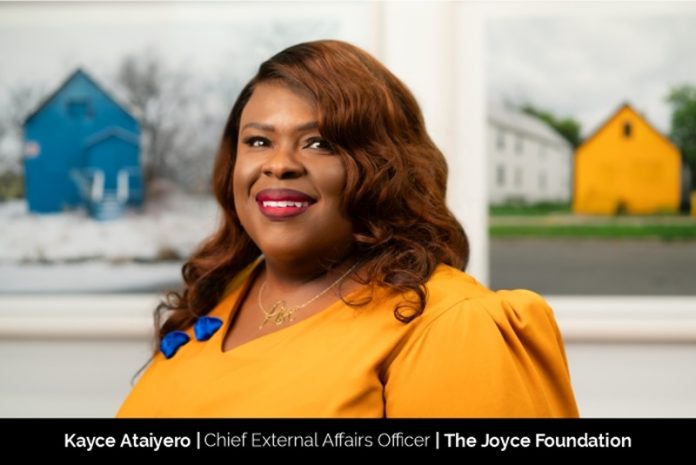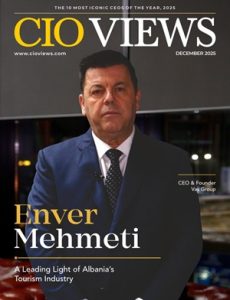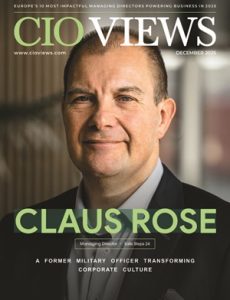Kayce Ataiyero views her lived experiences as both an asset and an assignment – the responsibility to create opportunities for others. Throughout her career, she has opened doors for many. As a leader, she wants her presence to matter – not just through the impact of the work but also in the people who were hired, funded and supported, who might not have been otherwise. To her, this is how one makes a difference that endures.
Over the years, Kayce has traversed multiple career paths with remarkable ease and brilliance, achieving success and impact in every field. As a journalist, she told slice-of-life stories about the quirks of humanity. When she transitioned into politics, she worked to make government more accessible to people. Now, as Chief External Affairs Officer at The Joyce Foundation, she is helping to demystify public policy. She is helping people understand that many of the seemingly intractable problems we face as a society have evidence-informed solutions. “We work to support public policy that builds pathways to opportunity,” Kayce says.
The Path Leading to Journalism
Kayce grew up in Washington, DC, when it was the murder capital of the United States, a city that was eating its young. As a little black girl trying to find her way in the world, it was a tough time for her. The library became her escape.
“I got my first library card when I was three,” she recalls. “My mom would take my brother, sister, and me on the subway to libraries in better parts of town, and I would burrow into the books.” She soon developed a love for the written word.
Where she came from, people made money with their hands, not their minds. So, it never occurred to her that she could make a living as a writer until she won a college scholarship from the Washington Post. This is what launched her career as a journalist.
After graduating with a degree in journalism from the University of Maryland College Park, Kayce’s first job was as a two-year resident reporter at The Philadelphia Inquirer. She worked as a general assignment reporter in the Bucks County bureau. Later, she moved to North Carolina to work for The News & Observer, and then to Chicago to work for the Chicago Tribune.
The Most Impactful Story
Kayce was working at The Philadelphia Inquirer when the 9/11 terrorist attacks took place. Since the pilot of the second plane that hit the towers lived in Bucks County, her beat, she was dispatched to talk to his family. “This was long before social media and the hyper-fast news cycle,” Kayce says. “I had a system for talking to loved ones that worked then but wouldn’t today.” She would look for the casserole. She explains that if someone is bringing a casserole to a grieving family, they are close enough to want to be of comfort but have enough emotional distance to be able to make a casserole.
Kayce pulled up in front of the pilot’s home and waited. Soon after, a man arrived with his son—and a casserole dish. Kayce introduced herself and asked if he would ask the family if they would speak with her. He agreed to do so. However, the pilot’s wife didn’t want to talk to the media but appreciated Kayce’s approach. According to Kayce, she had sequestered her children away from the TV, which at that point was playing the moment their dad died on a continuous loop, and she was trying to figure out how to tell them their dad wasn’t coming home.
“I was so glad I didn’t knock on her door,” Kayce says. “I still got the story.” She was one of the few reporters to have a front-page byline on September 12, 2001. She remembers that when the papers were delivered to the office, she felt almost guilty. “I was a young reporter, and having a front-page byline—my first—was huge, but the way I got it felt awful,” she shares. “I wanted nothing to do with it.”
Kayce’s editor asked her to take a few copies and put them away for safekeeping, saying that one day, with enough time passed and emotional distance, she would be glad to have them. And he was right. Today, a framed copy of that front page is hanging in Kayce’s office. “That was the launch of a journalism career that took me next to North Carolina to work for The News & Observer,” she says.
Changing Course: Moving Away from Journalism
Kayce once thought she would be a journalist forever. But she joined the Chicago Tribune at the height of the turbulence for the Tribune company and for news business writ large.
“I started in the summer of 2005, and they had the first round of layoffs that fall,” Kayce says, “and seemingly every quarter after that until I grew tired of the motion sickness and headed for the door.” She made the leap to politics, a field she engaged in but never actually covered as a journalist, save for one Barack Obama rally in St. Louis in the runup to his election as President. Kayce went to work for the former state treasurer, Alexi Giannoulias, who was running to replace Obama in the Senate.
It was a bit of a gamble. If Giannoulias won the Senate race, there would be opportunities in his office. But if he lost, he only had 13 months on his term as treasurer. “Given the rockiness at the Tribune, I said that if he could promise me a job for 13 months, that was more than the Tribune could,” Kayce recalls. “So, I took it and had a job for 13 months.”
After that, she served as press secretary to then-Illinois Governor Pat Quinn and then became the first communications director for Illinois Congresswoman Robin Kelly, with whom she had previously worked in the treasurer’s office. This job took Kayce back to her hometown of DC, where she worked in Congresswoman Kelly’s office on the Hill. She helped establish Congresswoman Kelly as a leading voice on gun violence prevention, in addition to building out her communications to explain the inner workings of Congress to her constituents back in the 2nd District of Illinois. She then worked briefly as Director of External Affairs for Cook County State’s Attorney, Kim Foxx, before making the leap to philanthropy, joining the Joyce Foundation in 2018.
At the Joyce Foundation, Kayce started as Senior Communications Officer, then became Director of Communications, followed by Managing Director of Communications. In 2021, she stepped into her current role as Chief External Affairs Officer. “The throughline of all my prior roles in journalism, politics and philanthropy is using storytelling as a gateway to inclusion,” Kayce says.
About The Joyce Foundation
The Joyce Foundation is a private, nonpartisan philanthropy. It invests in public policies and strategies to advance racial equity and economic mobility for the next generation in the Great Lakes region. Kayce calls the Foundation a “very entrepreneurial place.” According to her, it hires smart people who are leaders in their fields and then gives them the runway to launch exciting things.
“The many roles and expanded responsibilities I’ve had in my nearly 7 years at Joyce are the result of the Foundation letting me run with my ideas,” she says. “I’m really fortunate to work somewhere with high ceilings and high expectations.”
Developing Three Pillars of the Department
At the Joyce Foundation, Kayce spearheaded three initiatives: Strategic Communications, the Journalism Program, and the Lend a Hand Fund. Three years ago, the Foundation created a new department, External Affairs, to bring these initiatives under one umbrella in a comprehensive outreach and engagement strategy, according to Kayce.
Strategic Communications – This involves proactive communications to elevate the Foundation’s subject matter expertise in six program areas – Culture, Democracy, Education and Economic Mobility, Environment, Gun Violence Prevention and Justice Reform, and Journalism. In addition, the communications help educate the field about the work of Joyce’s grantees, while also informing the debate around its issue areas with the goal of advancing evidence-informed public policy strategies to tackle the most pressing issues facing the city of Chicago, the Great Lakes region, and the country as a whole.
A signature initiative of the communications vertical was the Joyce 75th anniversary project. According to Kayce, it illustrates the long game of the Foundation’s work over decades of public policy grant-making and the lessons learned from work aimed at solving seemingly intractable problems.
Journalism – For decades, Joyce has funded journalism – but on an ad hoc basis. At the same time, Kayce and her team were finding news coverage of Joyce issue areas dwindling because of the contraction of the news industry. She explains that journalism is vital in interrogating public policy ideas and in holding public institutions accountable when implementing public policy.
So, Kayce and her team created a strategy that focused the Foundation’s journalism investments on rebuilding the ranks of public policy and public affairs reporting in the region. That strategy led to the creation of a new $5 million Journalism program that supports public affairs reporting and the rebuilding of the media ecosystem in the Great Lakes region. Thanks to the efforts of her team in advancing and expanding the strategy, the Journalism program has become a national leader in journalism funding. Her leadership in journalism funding expanded in May when she became board chair of Media Impact Funders (MIF), the organization of U.S. and international funders of journalism and documentary film. MIF is in the midst of a leadership transition as Kayce leads the search for its new executive director. The transition is happening at a critical time for safeguarding journalism and media. MIF’s work will be critical to philanthropic efforts to empower journalists, filmmakers and storytellers to hold power accountable in support of our democracy.
Kayce is also on the steering committee for Press Forward Chicago, the local chapter of the $500 million Press Forward national initiative to revitalize local news. She believes that local news is the lynchpin of a healthy democracy, and thus supporting its sustainability and growth is critically important for the whole of society.
Lend a Hand – The Lend a Hand Fund provides support to community organizations that help Chicago residents most affected by the COVID-19 pandemic and systemic racism.
In the summer of 2020, Kayce led the launch of The Fund in response to the uprising following the murder of George Floyd and the impact it had on Chicago communities already reeling from the effects of COVID. She points out that the Fund began as a rapid-response initiative, led by a Foundation-wide task force. Initial funding supported various needs, including COVID testing and education, rental assistance, and food assistance. But as the nature of the crisis evolved, so did the Fund. It now focuses on supporting recovery efforts with a community health lens, led by a dedicated program officer.
So far, the Fund has distributed nearly $5 million to roughly 80 community organizations. It has become a cornerstone of the Foundation’s community engagement efforts.
Kayce believes that the most important thing a civic organization can do to demonstrate its values is to show up for the community. “With the Lend a Hand Fund, we show up for our friends and neighbors in a meaningful way,” she adds.
Continuous Learning is Key to Leadership
Kayce derives her inspiration from continuous learning. For her, Joyce is a learning institution, and she feels “very fortunate” to work with the most brilliant, passionate, and committed team.
“We have a lot of opportunities for formal conversations about the work, and those are always so illuminating,” she adds. “But it’s the casual brilliance of the Joyce team that I’m so inspired by, the impromptu conversations in the cafe or office pop-ins that make me so much smarter.”
Kayce also learns from the broader field of philanthropy, engaging with current and potential funding partners and grantees across the country. In recent years, there have been some big shifts in leadership in philanthropy and the broader nonprofit sector, ushering in dynamic new thinkers and doers who are informing and influencing philanthropy in transformative ways. “They, too, inspire and excite me about the potential evolution of philanthropy to be more reflective of and responsive to the communities we serve,” Kayce says.
Advice for Aspiring Leaders
“Take up space like you belong there, because you do,” Kayce advises aspiring women leaders in communications, journalism, and politics. She encourages them to play their game and not let other people pressure them into playing by their rules.
“I used to be general manager for the Chicago Steam, a minor league basketball team in the ABA,” she shares. “We didn’t always have the most talented roster, but we made sure our guys were conditioned so that they could play a fast game baseline-to-baseline for 48 minutes, and we would win by just wearing our opponents down.”
“Figure out the style of play that works best for your game,” she adds. “Play to your strengths, to what makes you unique – and play to win.”





